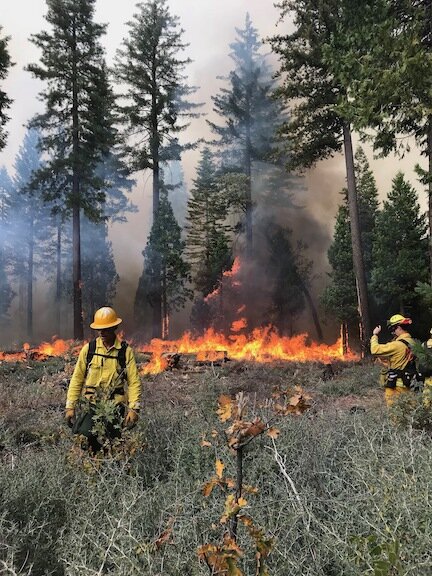Sept. 2021 Science Corner | Transcending Parallel Play: Boundary Spanning for Collective Action in Wildfire Management


In a new paper, Blue Forest Science Advisors Dr. Emily Jane Davis, Dr. Heidi Huber-Stearns, and their co-authors, bring a social science lens to wildfire risk management to better define these hurdles and identify mechanisms for overcoming them.
Authors: Davis, Emily J., Heidi Huber-Stearns, Antony S. Cheng, and Meredith Jacobson. 2021. https://doi.org/10.3390/fire4030041
Interview and story by: Tessa Maurer
As we look to address the current wildfire challenge across Western U.S. forests that are owned and managed by a wide variety of federal, state, and local government agencies, private individuals and landowners, collaboratives and other organizations, there are a number of barriers to implementing large-scale restoration projects. In most cases, understanding what to do is not one of the barriers: broad scientific consensus supports forest restoration, home hardening, and community defense actions that can best reduce the impacts and risk of catastrophic wildland fire. Instead, one of the biggest barriers to effectively reducing wildfire risk actually comes from differences across institutional, social, and jurisdictional boundaries. In a new paper, Blue Forest Science Advisors Dr. Emily Jane Davis, Dr. Heidi Huber-Stearns, and their co-authors, bring a social science lens to wildfire risk management to better define these hurdles and identify mechanisms for overcoming them.
“We were motivated to do this paper because, as social scientists, there’s a lot of dialogue about collaboration, but the literature is vast and, as practitioners and managers, it can be bewildering to think – how do we work together better?” commented Dr. Davis. Based on a review of existing literature, the authors present a typology of boundaries that exist in the context of wildfire management. They identify four primary types: land ownership, functional, organizational, and conceptual. Land ownership is perhaps the most obvious, as it involves physical boundary lines. “But from our position, the boundaries people often talk to us about are these other ones around resource sharing or implementing agreements,” according to Dr. Huber-Stearns.
Different types of boundaries also intersect and overlap. “For example,” said Dr. Davis, “our colleagues have found that when you go to work across land ownership boundaries you run into organizational boundaries of different missions, cultures, or structures that make it hard to do basic things like move and share resources in the ways they’re needed on the ground.”
The authors also identify several mechanisms for crossing these boundaries. Dubbed “Boundary Spanning Features”, these mechanisms include people and/or organizations, objects, concepts, and settings that can help address one or more of the boundary challenges. The authors discussed how these tools – ranging from written agreements like MOUs to the formation of cooperative entities like coalitions or forest collaboratives – can facilitate cross-jurisdictional work. A good example is spanning the functional boundary between teams, even within the same organization, that focus on fire mitigation versus fire response.
“For co-management of wildfire, we see a lot of work happening in prescribed fire: helping write burn plans, bringing different crews together, and we see that then translating to those same entities being able to conduct managed fire activities together because they have these pre-established relationships,” said Dr. Huber-Stearns. “If the goal ecologically is to return fire to the landscape and the goal socially is to live with fire, then that needs to be integrated,” added Dr. Davis.
Social and institutional challenges to planning and implementing fire risk reduction actions like forest management are frequently nebulous and ill-defined. As such, they are challenging for the scientific and management community to address, despite often presenting the biggest barriers to getting work done. By developing and applying definitions and classifications to make these issues more tangible, Dr. Davis and Dr. Huber-Stearns’ paper can help project developers and organizations better articulate challenges they face and identify effective mechanisms for overcoming them. As we at Blue Forest look to implement forest restoration projects at a meaningful pace and scale, their framework provides a critical perspective on barriers to wildfire risk management that are often overlooked and provides tools to help support implementation.
_____
This research is part of an applied research project: “Co-Managing Risk or ‘Parallel Play’? Examining Connectivity Across Wildfire Risk Mitigation and Fire Response in the Intermountain West”, funded by Joint Fire Science Program. Project partners: Tony Cheng and Mike Caggiano (Colorado State University), and Darren McAvoy (Utah State University).